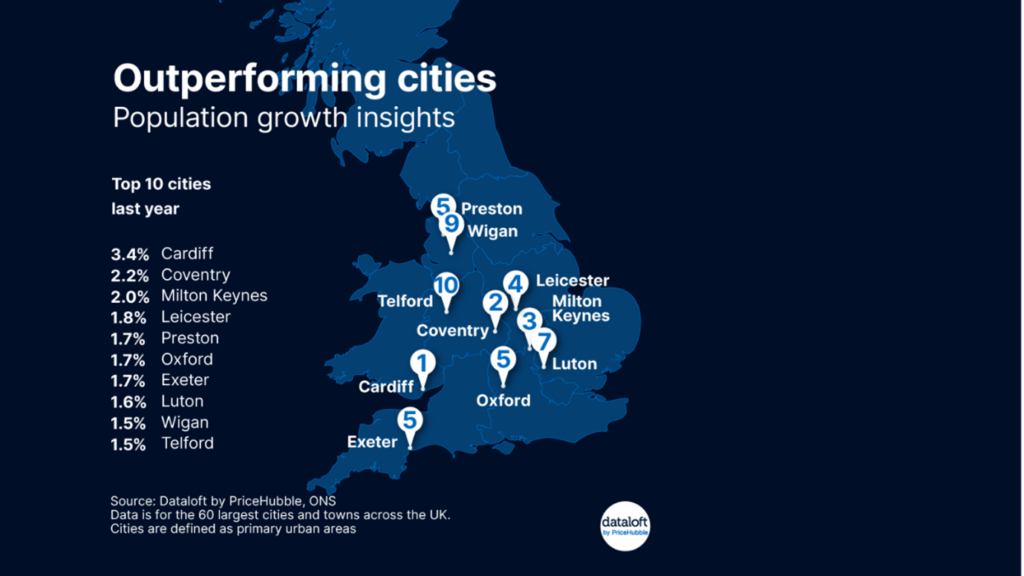Population trends offer a fascinating glimpse into the shifting dynamics of cities across the UK. As urban areas grow, they become hotspots for housing demand, employment opportunities, and cultural development. According to the latest data from Dataloft by PriceHubble, certain cities are excelling in attracting new residents, driven by factors such as a robust jobs market, housing affordability, and a high quality of life. Let’s take a closer look at the UK’s top 10 cities with the highest population growth and explore what makes them attractive destinations.

The Top 10 Cities for Population Growth
- Cardiff – 3.4%
Leading the charge is Cardiff, with an impressive 3.4% population growth. The Welsh capital’s dynamic economy, thriving cultural scene, and excellent transport links have made it a magnet for new residents. Cardiff’s vibrant lifestyle and employment opportunities are key factors driving this growth. - Coventry – 2.2%
Coventry stands out not only for its population growth but also for its ability to retain and attract young people aged 21–32. This city boasts a strong jobs market, affordable housing options, and a strategic location close to major UK hubs like Birmingham and London. - Milton Keynes – 2.0%
Known for its modern infrastructure and growing economy, Milton Keynes continues to see a rise in population. Its strong jobs market is a significant draw, supported by affordability compared to nearby London. With its planned city structure and green spaces, it’s an increasingly popular choice for young professionals and families alike. - Leicester – 1.8%
Leicester’s 1.8% growth reflects its appeal as a city rich in culture and diversity. With an affordable housing market and a burgeoning economy, Leicester is attracting both families and professionals. Its vibrant community and educational institutions further enhance its desirability. - Preston – 1.7%
Preston is another city on the rise, experiencing a 1.7% population growth. Known for its affordability and proximity to major Northern cities like Manchester and Liverpool, Preston offers a balanced lifestyle with growing employment opportunities. - Oxford – 1.7%
Oxford combines its world-class academic reputation with a thriving economy, making it an attractive location for residents. While housing affordability may pose a challenge, its strong employment market and cultural allure continue to draw in new residents. - Exeter – 1.7%
Exeter’s population growth reflects its consistent performance over the past decade. Scoring highly in terms of jobs and its ability to attract young residents, Exeter offers a mix of coastal charm and city convenience that appeals to many. - Luton – 1.6%
Luton’s 1.6% growth highlights its appeal as a commuter town with excellent transport links to London. Affordable housing and a diverse community make it a popular choice for those seeking urban connectivity without the high costs of living in the capital. - Wigan – 1.5%
Wigan’s affordability and family-friendly amenities have helped drive its population growth. Situated within commuting distance of Manchester, it offers a more cost-effective option for workers seeking proximity to a major metropolitan area. - Telford – 1.5%
Rounding out the list, Telford has shown consistent growth, supported by an affordable housing market and a strong local jobs market. Its strategic location and family-friendly appeal make it a compelling choice for new residents.
Why These Cities Are Thriving
The common threads among these top-performing cities are affordability, job opportunities, and a focus on attracting younger residents. Cities like Coventry and Exeter, which score highly in retaining individuals aged 21–32, highlight the importance of creating environments where young professionals can thrive. Meanwhile, places such as Telford and Leicester leverage affordability as a competitive edge, making them more accessible to a wider demographic.
Milton Keynes, Telford, and Exeter are examples of cities with strong and diverse jobs markets. This economic stability not only attracts residents but also supports sustainable growth over time. It’s worth noting that many of these cities have outperformed their peers consistently over the past decade, indicating a long-term trend rather than a short-lived spike in growth.
The Impact of Population Growth on Housing Demand
As population numbers rise, so does the demand for housing. These cities’ ability to grow while maintaining a balance of affordability and amenities is a testament to their forward-thinking urban planning. For property investors, understanding these trends can be crucial when considering where to invest. Buyers and renters alike are drawn to cities that offer economic opportunity, cultural vibrancy, and high-quality living standards.
What This Means for the UK Property Market
Population growth is a key driver of housing demand, and these thriving cities represent opportunities for homeowners and investors. With increased interest in regions outside London, these areas are likely to see continued demand for housing. For landlords and investors, understanding the unique characteristics of each city can help identify where to focus their efforts.
Ready to Explore Housing Opportunities?
Whether you’re considering moving to one of these vibrant cities or exploring property investment opportunities, Northwood can help. Our local experts provide tailored advice to help you find the perfect home or maximise your investment potential. Get in touch with your nearest Northwood office today to learn more about the opportunities in these rapidly growing urban centres.






